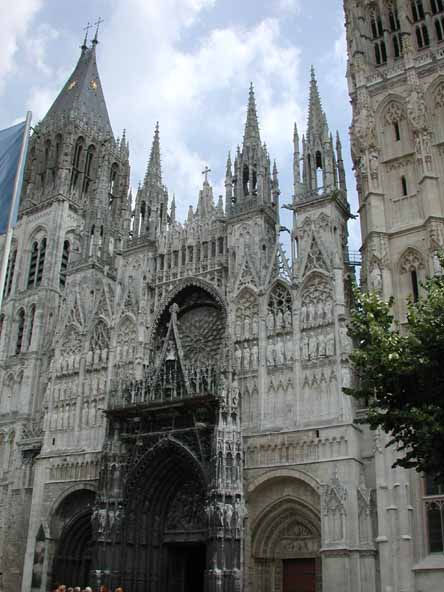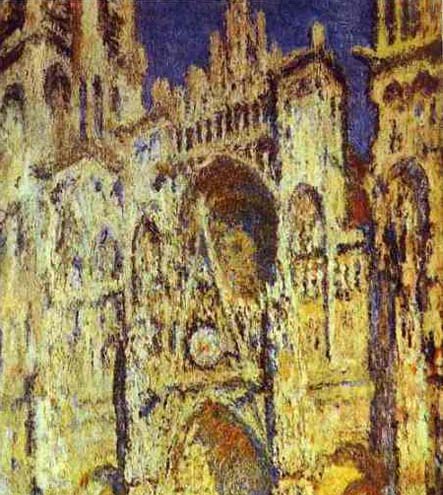|
|
July, 2003. It was a slow summer day here in Paris. The weather was bright and fine,
French trains had last-minute fare promotions, and Vicki and I had nothing much scheduled. For seventeen dollars roundtrip per person, we went to Rouen.
I had never been there, and knew only four things about Rouen. First, I knew Rouen was in Normandy on the river Seine, about an hour by train northwest of Paris in the direction of the English channel. Second, the English or the French or both, so confusing, burned Joan of Arc alive at a stake there. Third, Monet painted the Rouen cathedral over and over. And over and over. I'd seen those paintings in the Marmottan museum in Paris, and other versions elsewhere, so many times. Fourth, Rouen was home to novelist Gustave Flaubert. By coincidence I'd just finished rereading Madame Bovary, Flaubert's masterpiece, and found Emma Bovary to be much more sympathetic than I'd remembered her. In some confused way I thought a trip to Rouen might make me understand her better. I should say right now I'm in love with Madame Bovary, she deserved better, but that's another story.
Vicki and I left the Saint Lazare train station at 9:15. Back in the 19th century Saint Lazare was one of Paris's first stations, and the line through Normandy one of France's first tracks. Impressionist painters including Monet painted the Saint Lazare
station. They were thrilled by the adventure that trains represented. They took rides on the Normandy trains and painted what they saw. The whole impressionist movement could be said to originate from a seat on the train. Impressionists tried to paint what the scenery looked like, the way the light bounced around, as they saw it from trains racing through the countryside at an astonishing fifteen miles an hour.
These days you get to Rouen faster, but the trip takes you past factories, auto assembly plants, hyper markets, and junk yards, as well as pretty green fields and forests. Then we were there. Away off to the left we could see old Rouen, and the river, and the cathedral that Monet painted, and other churches, too, with their steeples shooting up to God. The train went through a tunnel, and then stopped at the Rouen Rive Droit station. The town was laid out between the station and the river, and we could see it in front of us, shining in the sun.
I'd taken a list of restaurants from the Michelin Guide Rouge. Vicki is a vegetarian, and we select restaurants partly based on their meatless
dishes. We looked first at the Bistrot du Chef en Gare, highly recommended, right in the train station. But the restaurant was closed. A sign said it was closed for vacation from June something to September something, the entire summer, the entire tourist season, when all those English and German and Dutch tourists would descend on the Rouen train station, clutching their Michelins. Closed.
We wandered through old town, admiring the French Norman architecture, exterior walls of hand-hewn wood boards alternating with painted organic material. I took pictures of Rouen's gothic cathedral, and tried to imagine where Monet sat when he painted it. I began to feel vaguely uneasy somehow, but let it pass at the time. We went into a cafe, and there was a woman there wearing too much makeup, and talking to herself. I figured she'd order a beer, but she, too, drank coffee. She talked with the barman, and with us, and welcomed us to Rouen. But mostly she talked to herself.
We had lunch at Gill, the best restaurant in Rouen, the showpiece of celebrity chef Gilles Tournadre. Gilles serves an executive lunch for $40, four courses, with starter, a fish dish, a meat dish, and dessert, and several other wonderful things before and after. Vicki and I had a scaled-down version of the executive lunch. The fish course, cod with vegetables, was the highlight. I can never, ever get codfish to taste
so moist, flaky, tender, and delicate. With coffee we were served a platter of those little pastry, chocolate things the French call petits-fours, delicious.
We went to old market square where Joan of Arc was burned alive in 1431. The English were in control of Rouen at the time, but Joan was tried and convicted by the French. Presumably Charles VII agreed to the horrible death. A modern silver cross marks the spot, but the actual spot was at medieval soil levels. What we walk on today is several
meters above what Joan walked on; we walk on six centuries of compacted waste material. Next to the stake was the new Joan of Arc church, built in 1979. Ever since the women's movement the French have been in a Joan of Arc revival mode. But on this day the Joan of Arc church, too, was closed.
We went to another gothic church, called Saint Ouen's Abbey, and I suddenly knew why I'd felt uneasy at the cathedral. The Monet paintings I remembered looked more like Saint Ouen's Abbey than the cathedral. Monet must have painted the cathedral, he said he painted the cathedral, Saint Ouen's Abbey is far less important than the cathedral. But see for yourself. The Rouen cathedral (my picture on the
top) has two spires each to the left and right of the main door, between
the main door and the big towers, that are missing in the Monet
painting. What's going on here? All gothic cathedrals may look
alike, but this was too much.
 
We spent the rest of the afternoon at Rouen's fine arts museum. The museum has a special exhibit on paintings of and about Joan of Arc. Revivalism. The museum also has an outstanding collection of Impressionist paintings, including a Monet of the Rouen cathedral. I studied the painting, and the playback screen on my digital camera, and compared the two. The girl in the gift shop assured me that Monet had indeed painted the cathedral, that Saint Ouen's Abbey was too ugly to be painted by Monet, that maybe Monet painted the side of the cathedral rather than the facade. Then I read in the catalog that, no, Monet had painted the cathedral's facade. Further, he wanted his cathedral paintings to be framed as if they were photographs. He painted the Rouen cathedral facade thirty times, in every case with photo-framing.
I went back to the cathedral and took more pictures. I finally decided that Monet must have painted the cathedral from
farther off to the right side. The spires on the left were invisible from that angle, washed into the background. Some of the visible spires could have been added later. The Rouen cathedral suffered severe wind damage during a storm in 1999, maybe the spires were added then.
The mystery seemed solved. Vicki and I went to a cafe. I was still in love with Madame Bovary, although I doubted I understood her better after my trip to Rouen. I thought about her a lot. Maybe she was just a sex object. I marveled once more that a misogynist like Flaubert could create such an unforgettable woman.
At 19:10 hours we took the train back to Paris. Paul P.S.
To see more pictures of Rouen, including the Joan of Arc church, what
must have been Monet's view of the cathedral, Saint Ouen's Abbey, Norman
architecture, and more, click here. |